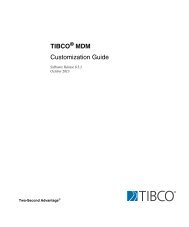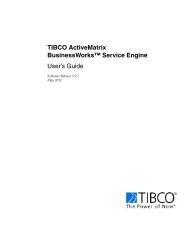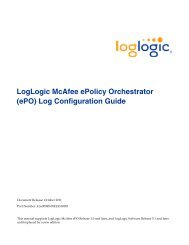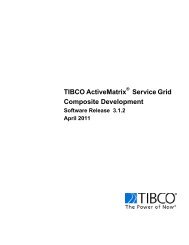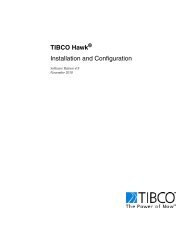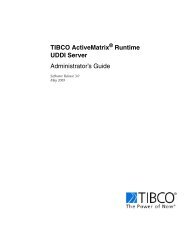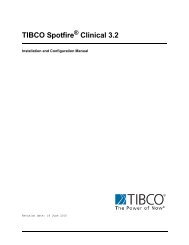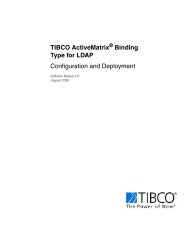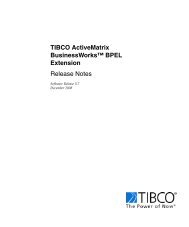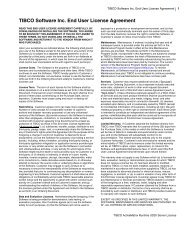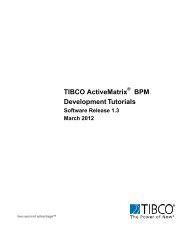TIBCO Spotfire Server 3.2.2 - TIBCO Product Documentation
TIBCO Spotfire Server 3.2.2 - TIBCO Product Documentation
TIBCO Spotfire Server 3.2.2 - TIBCO Product Documentation
You also want an ePaper? Increase the reach of your titles
YUMPU automatically turns print PDFs into web optimized ePapers that Google loves.
Backup and Restore<br />
10 Backup and Restore<br />
10.1 Overview<br />
To ensure quick and easy recovery after a crash or disaster in your <strong>Spotfire</strong> system, it<br />
is important that you back up information stored in the system. This information<br />
includes user files, configuration, etc. Most of this is stored in the <strong>Spotfire</strong> Database,<br />
but some of it is stored on the <strong>Spotfire</strong> <strong>Server</strong>(s) and The <strong>Spotfire</strong> Web Player server.<br />
This manual will not describe how to perform backups, only what to back up. It is<br />
assumed that you have some sort of backup software for files and computers, and that<br />
you use the backup tools provided by your database vendor. Refer to their<br />
documentation for instructions on how to perform backups.<br />
10.2 <strong>Spotfire</strong> Database<br />
The most important part of the <strong>Spotfire</strong> system to back up is the <strong>Spotfire</strong> Database.<br />
This is where most of the user data and configuration is stored, and even if you do not<br />
have valid backups of other components of the <strong>Spotfire</strong> system, you will be able to<br />
restore functionality after a crash if the database is backed up. It is therefore vital that<br />
you have a valid and current backup of the <strong>Spotfire</strong> Database.<br />
10.3 <strong>Spotfire</strong> <strong>Server</strong>(s)<br />
Stored on the <strong>Spotfire</strong> <strong>Server</strong>(s) is configuration that is unique to each <strong>Spotfire</strong> <strong>Server</strong><br />
in the cluster, such as authentication information regarding NTLM, Kerberos, Client<br />
Certificates, etc. Even if you lose this data, you will be able to get a <strong>Spotfire</strong> system<br />
back after a crash, by installing a new server and adding it to the cluster. For simple<br />
systems, where no or very little configuration is performed, this may even be enough.<br />
If you have made any configuration changes, however, such as listening ports,<br />
authentication, user directory, etc, you probably want to ensure that you have a valid<br />
backup of your <strong>Spotfire</strong> <strong>Server</strong>(s). Configuration stored on the <strong>Spotfire</strong> <strong>Server</strong>(s)<br />
includes the following:<br />
• Listening ports configuration (see the section “Run Installer” on page 23 and<br />
“<strong>Server</strong>.xml” on page 135 for more information about this)<br />
• Information about how to connect to the <strong>Spotfire</strong> Database (see the section<br />
“Database Connection Configuration” on page 138 for more information about<br />
this)<br />
• Logging configuration (see the section “Changing the Default Log Level of the<br />
<strong>Spotfire</strong> <strong>Server</strong>” on page 132 for more information about this)<br />
• Memory configuration (see the section “Modifying the Virtual Memory” on<br />
page 103 for more information about this)<br />
128 (144) <strong>TIBCO</strong> <strong>Spotfire</strong>® <strong>Server</strong> <strong>3.2.2</strong>



